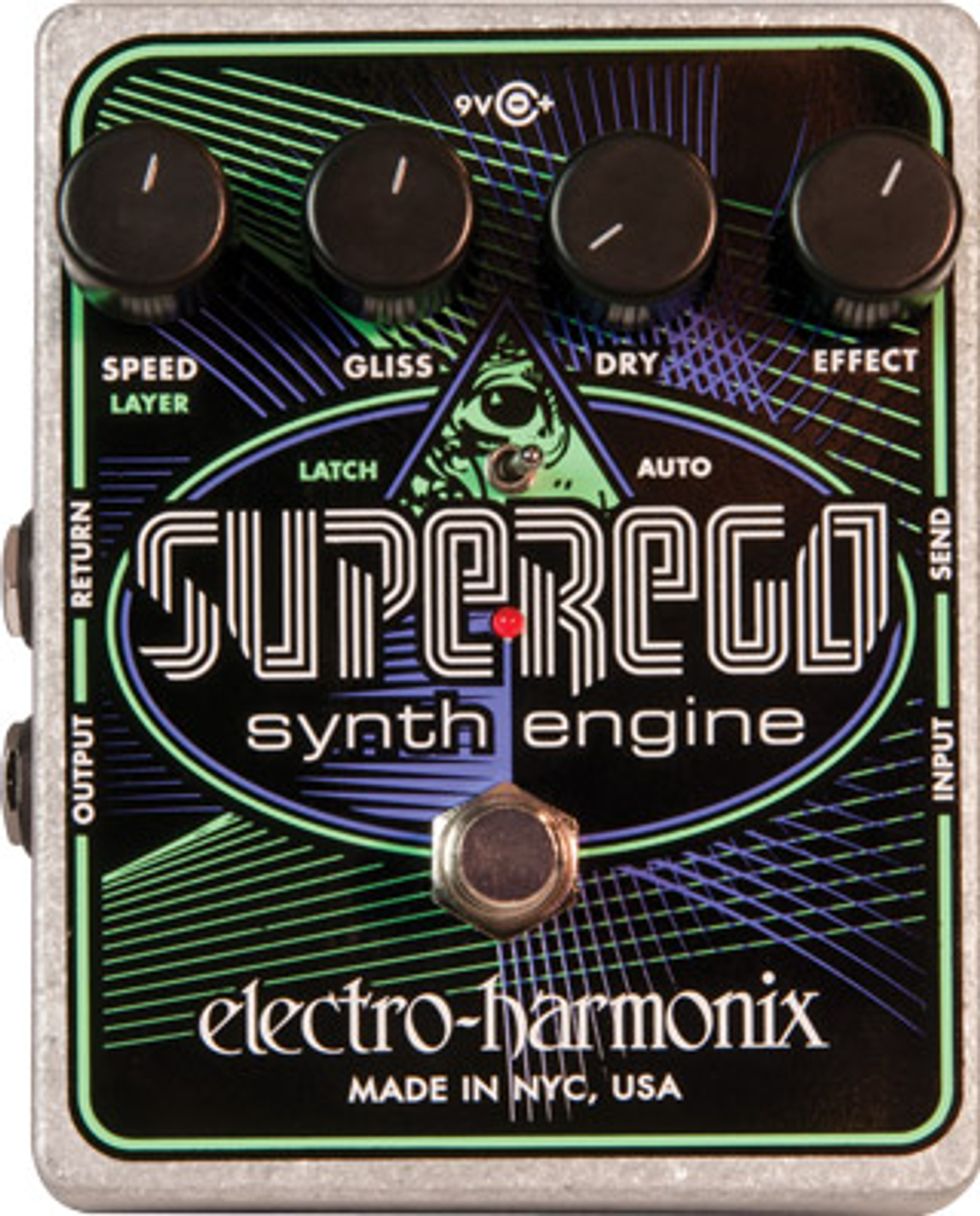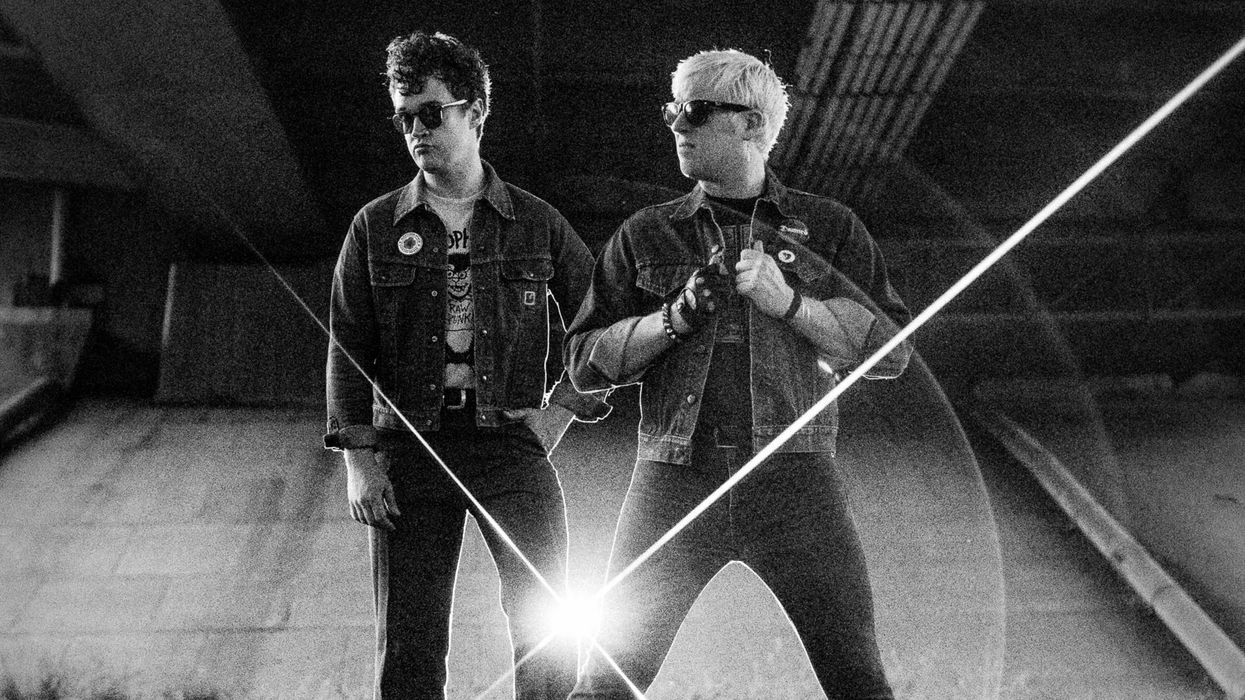
If you’re a fan of out-of-the-ordinary guitar tones, you’re probably intrigued by Electro-Harmonix’ Freeze pedal. The ability to sample a little chunk of sound and then mangle it with effects pedals—effectively enabling players to turn their pedal boards into modular synths—has kept adventurous guitarists twitching with the sense of possibility.
Never a company to rest on their laurels, Electro-Harmonix has now introduced the Superego, which builds on the Freeze principle with cool auto mode, an effects loop, and a gliss control that behaves like a portamento when moving between notes. For sonic tweakers, this is the kind of device that makes it hard to hold back mad-scientist cackles.
Super Freak
Since the Superego is effectively
a synth pedal, the controls
might be less than totally familiar
to the average guitarist. One
of the most important features is
the three-way switch that selects
between latch, momentary, and
auto modes. They dictate how
the footswitch works, but can
also change the function of individual
controls entirely. In latch
mode, for instance, the speed
knob—which otherwise controls
the attack and decay rate of a
frozen tone—dictates the number
of layers the latch mode will
play back at once.
The gliss control approximates the portamento control on a synth—creating glides from note to note or one chord to another. Dry controls the relative volume of the dry and synth-like effected signal. There’s also a built-in effects loop, which really expands the way you can tinker with the wet/dry signal relationship.
The hardware is what we’ve come to expect from Electro-Harmonix pedals these days—it’s not overbuilt and bulky, but it doesn’t feel the least bit flimsy either. And it’s a compact pedal considering how many crazy features lurk within the unit. This thing is cool looking too, and with the Eye of Providence and green and blue line work from out of an ’80s arcade game, you won’t mistake this pedal for anything else on your board.
Dream Machine
To test the Superego and take
advantage of the effects loop,
I set up the Superego with a
tremolo and a chorus pedal (in
the loop), ran delay, distortion
and wah on either side of the
EHX, and routed the whole
array into a ’60s blackface
Fender Twin.
What’s immediately impressive about the Superego is the ease with which you can access tones that are typically feasible only with the help of studio trickery. The latch mode is extremely useful for sampling your own sounds on the fly to build a backdrop texture—especially sweet if your organ player has called in sick. It’s easy to generate Eno-esque ambient soundscapes by strumming a chord as you hit the switch and then playing melodically over the captured sound.
With the addition of a little distortion and chorus, and engaging the Superego’s gliss function, I nailed the gliding guitar tones from My Bloody Valentine’s “To Here Knows When” without having to use delay or whammy bar techniques. It’s also easy to cop sounds from Radiohead’s “Treefingers” off their album Kid A with the latch mode, reverb, and a little distortion.
Ratings
Pros:
Near-infinite tonal possibilities.
Cons:
Somewhat strident high end. Latch/intelligent
trigger thresholds are not as responsive as
they could be.
Tones:
Ease of Use:
Build:
Value:
Street:
$212
Electro Harmonix
ehx.com
The momentary mode lets you accent and texture a part with more freedom on the fly because it will only trigger when the footswitch is held down—great for adding emphasis to a single dramatic note or chord in a solo. The auto mode puts everything you play through the synth engine. Chords will blend dramatically (depending on the gliss amount) and slower speed settings can highlight harmonics and artifacts in very cool ways.
The Superego can feel a little tricky, largely because the threshold that determines when a sound is sampled is set pretty high (most likely because you don’t want to trigger the pedal inadvertently.) And you have to be very careful with picking technique, because digging in can create a tangle of unpleasant high-frequency harmonics. In general, the Superego can be a little intense in the upper frequencies, and you may find yourself reaching for the tone knob on your guitar or amp to strike the right balance.
The Verdict
The Superego could easily become
a centerpiece sound for some solo
musicians, but will dramatically
expand the palette of any guitarist
that plays the role of texturalist
in a band. There’s no shortage to
the types of tones that can be created,
depending on your playing
approach and the effects you use
around it. And this pedal can be
a virtual one-person symphony
in the right hands. At just over
200 bucks, the price of admission
might seem a little steep. But few
pedals do what the Superego does
in a compact form factor, and you
might have to buy multiple pedals
just to achieve this sound.
If you’re a dedicated tone explorer and texturalist, you’d be silly to pass this pedal up. And if you savor the art of transforming your guitar entirely, the Superego is an amazing place to start.

























